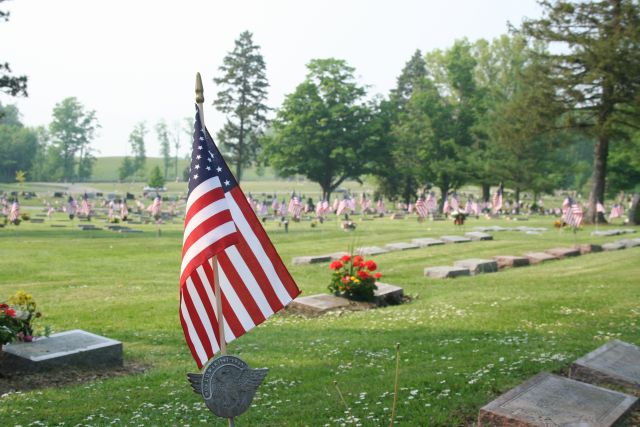|
The History of Memorial
Day
"It is, in a way, an odd
thing to honor those who died in defense of our country,
in defense of us, in wars far away. The imagination
plays a trick. We see these soldiers in our mind as old
and wise. We see them as something like the Founding
Fathers, grave and gray-haired. But most of them were
boys when they died, and they gave up two lives, the one
they were living and the one they would have lived. When
they died, they gave up their chance to be husbands and
fathers and grandfathers. They gave up their chance to
be revered old men. They gave up everything for our
country, for us. And all we can do is remember.”
President Ronald Reagan
Memorial Day was originally known as Decoration Day
because it was a time set aside to honor the nation's
Civil War dead by decorating their graves. It was first
widely observed on May 30, 1868, to commemorate the
sacrifices of Civil War soldiers, by proclamation of
General John A. Logan of the Grand Army of the Republic,
an organization of former sailors and soldiers. On May
5, 1868, Logan declared in General Order No. 11 that:
The 30th of May, 1868, is designated for the purpose of
strewing with flowers, or otherwise decorating the
graves of comrades who died in defense of their country
during the late rebellion, and whose bodies now lie in
almost every city, village, and hamlet churchyard in the
land. In this observance no form of ceremony is
prescribed, but posts and comrades will in their own way
arrange such fitting services and testimonials of
respect as circumstances may permit.
During the first celebration of Decoration Day, General
James Garfield made a speech at Arlington National
Cemetery, after which 5,000 participants helped to
decorate the graves of the more than 20,000 Union and
Confederate soldiers buried in the cemetery.
This 1868 celebration was inspired by local observances
of the day in several towns throughout America that had
taken place in the three years since the Civil War. In
fact, several Northern and Southern cities claim to be
the birthplace of Memorial Day, including Columbus,
Miss.; Macon, Ga.; Richmond, Va.; Boalsburg, Pa.; and
Carbondale, Ill.
In
1966, the federal government, under the direction of
President Lyndon Johnson, declared Waterloo, N.Y., the
official birthplace of Memorial Day. They chose
Waterloo—which had first celebrated the day on May 5,
1866—because the town had made Memorial Day an annual,
community-wide event during which businesses closed and
residents decorated the graves of soldiers with flowers
and flags.
By the late 1800s, many communities across the country
had begun to celebrate Memorial Day and, after World War
I, observances also began to honor those who had died in
all of America's wars. In 1971, Congress declared
Memorial Day a national holiday to be celebrated the
last Monday in May. (Veterans Day, a day set aside to
honor all veterans, living and dead, is celebrated each
year on November 11.)
.jpg) Today,
Memorial Day is celebrated at Arlington National
Cemetery with a ceremony in which a small American flag
is placed on each grave. Also, it is customary for the
president or vice-president to give a speech honoring
the contributions of the dead and lay a wreath at the
Tomb of the Unknown Soldier. About 5,000 people attend
the ceremony annually. Today,
Memorial Day is celebrated at Arlington National
Cemetery with a ceremony in which a small American flag
is placed on each grave. Also, it is customary for the
president or vice-president to give a speech honoring
the contributions of the dead and lay a wreath at the
Tomb of the Unknown Soldier. About 5,000 people attend
the ceremony annually.
Several Southern states continue to set
aside a special day for honoring the Confederate dead,
which is usually called Confederate Memorial Day:
-
Mississippi: Last
Monday in April
-
Alabama: Fourth
Monday in April
-
Georgia: April 26
-
North Carolina:
May 10
-
South Carolina:
May 10
-
Louisiana: June 3
-
Tennessee
(Confederate Decoration Day): June 3
-
Texas
(Confederate Heroes Day): January 19
-
Virginia: Last
Monday in May

For more information go to
http://www.usmemorialday.org/
|